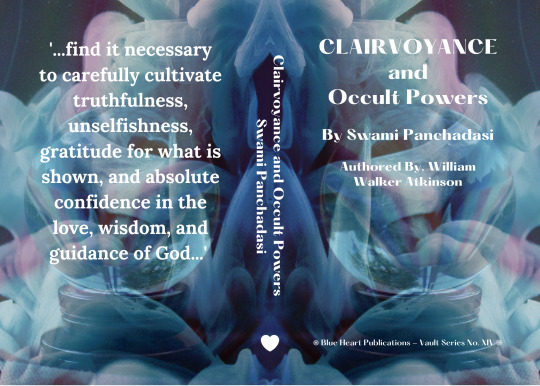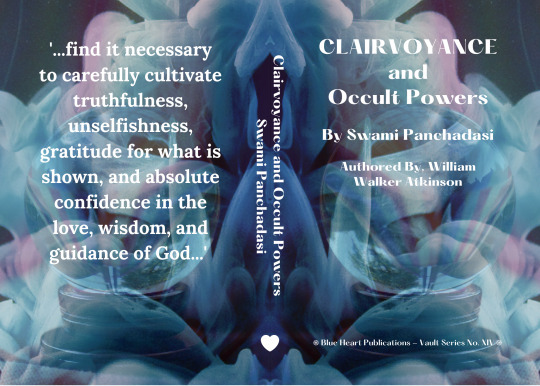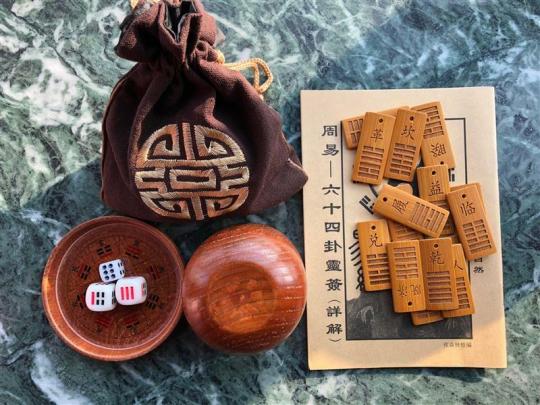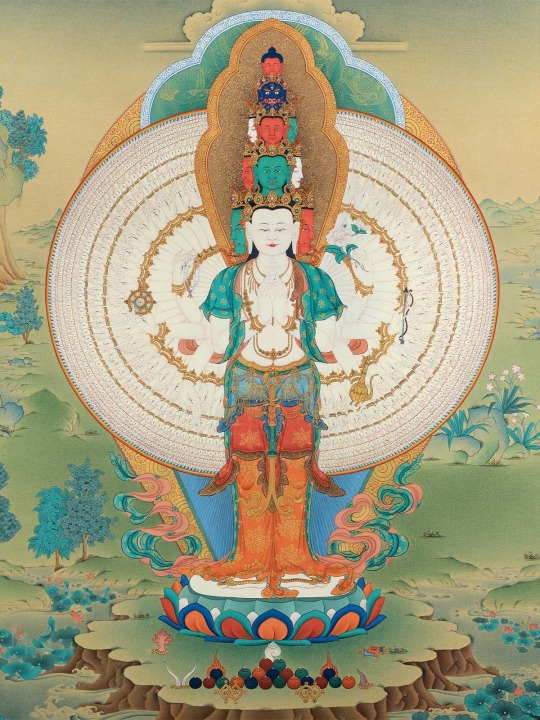#Eastern Mysticism
Explore tagged Tumblr posts
Text

4 notes
·
View notes
Text
"Unveiling the Unseen: A Profound Exploration of 'Clairvoyance and Occult Powers' by Swami Panchadasi"

Title: "Unveiling the Unseen: A Profound Exploration of 'Clairvoyance and Occult Powers' by Swami Panchadasi"
Swami Panchadasi's (A.K.A. Atkinson, William Walker) "Clairvoyance and Occult Powers" beckons readers into the enigmatic realms of extrasensory perception and mystical abilities. As I delved into the pages of this esoteric work, I found myself immersed in a fascinating journey through the intricacies of clairvoyance, the third eye, and the untapped potentials of the human mind. The title alone promises a profound exploration of occult powers, and Swami Panchadasi does not disappoint.
At the heart of the book lies an in-depth exploration of clairvoyance, the ability to perceive beyond the limitations of the physical senses. Swami Panchadasi, drawing upon his deep knowledge of Eastern mysticism, unveils the secrets of developing and harnessing this psychic faculty. His teachings guide readers through the nuances of opening the third eye, awakening dormant powers, and tapping into the unseen forces that permeate our existence.
One of the notable strengths of Panchadasi's work is its accessibility. Despite delving into intricate metaphysical concepts, the author presents the material in a manner that is comprehensible to both novices and seasoned practitioners. The step-by-step instructions and practical exercises provided serve as a roadmap for individuals seeking to cultivate their latent psychic abilities.
The book also delves into various occult powers beyond clairvoyance, offering insights into telepathy, psychometry, and the manipulation of vital life forces. Panchadasi's approach is not merely theoretical; he provides practical exercises and guidance, inviting readers to embark on a personal journey of self-discovery and spiritual development.
What sets "Clairvoyance and Occult Powers" apart is its blend of Eastern mysticism and Western occultism. Swami Panchadasi draws from a diverse range of spiritual traditions, creating a synthesis that resonates with a broad audience. The inclusion of anecdotes, case studies, and historical references adds depth to the narrative, illustrating the universality of these mystical experiences.
While the subject matter may challenge conventional beliefs, Panchadasi approaches it with a sense of reverence and responsibility. The emphasis on ethical considerations and the cautionary advice regarding the use of occult powers underscore the author's commitment to guiding readers toward a balanced and mindful exploration of these mystical realms.
In conclusion, "Clairvoyance and Occult Powers" by Swami Panchadasi is a captivating exploration of the unseen dimensions of human potential. Whether one approaches it with skepticism or an open mind, the book offers a thought-provoking journey into the realms of the mystical and the metaphysical. Panchadasi's lucid prose, coupled with practical exercises, makes this work an invaluable resource for those curious about unlocking the hidden potentials of the mind and delving into the mysteries that lie beyond the veil of the material world.
Swami Panchadasi's (A.K.A. Atkinson, William Walker) "Clairvoyance and Occult Powers" is available in Amazon in paperback 14.99$ and hardcover 22.99$ editions.
Number of pages: 324
Language: English
Rating: 10/10
Link of the book!
Review By: King's Cat
#Swami Panchadasi#Clairvoyance#Occult powers#Third eye#Extrasensory perception#Mystic abilities#Eastern mysticism#Psychic faculties#Spiritual development#Metaphysical exploration#Practical exercises#Mystical experiences#Awakening the third eye#Psychometry#Telepathy#Vital life forces#Eastern and Western occultism#Self-discovery#Ethical considerations#Unseen dimensions#Hidden potentials#Mind-body connection#Occult practices#Astral perception#Meditation techniques#Metaphysical concepts#Personal transformation#Mystical traditions#Practical guidance#Spiritual growth
4 notes
·
View notes
Photo

It will be my wisest course to go at once to my God, to Christ Jesus, and not to wander in a roundabout manner to this friend and that ~ Charles H. Spurgeon
3 notes
·
View notes
Link
What have you been smoking?
#oligarchy#occult#cults#One World Religion#New Age#Blavatsky#Theosophy#drugs#Eastern mysticism#neofeudalism#deindustrialization
0 notes
Text
"Unveiling the Unseen: A Profound Exploration of 'Clairvoyance and Occult Powers' by Swami Panchadasi"

Title: "Unveiling the Unseen: A Profound Exploration of 'Clairvoyance and Occult Powers' by Swami Panchadasi"
Swami Panchadasi's (A.K.A. Atkinson, William Walker) "Clairvoyance and Occult Powers" beckons readers into the enigmatic realms of extrasensory perception and mystical abilities. As I delved into the pages of this esoteric work, I found myself immersed in a fascinating journey through the intricacies of clairvoyance, the third eye, and the untapped potentials of the human mind. The title alone promises a profound exploration of occult powers, and Swami Panchadasi does not disappoint.
At the heart of the book lies an in-depth exploration of clairvoyance, the ability to perceive beyond the limitations of the physical senses. Swami Panchadasi, drawing upon his deep knowledge of Eastern mysticism, unveils the secrets of developing and harnessing this psychic faculty. His teachings guide readers through the nuances of opening the third eye, awakening dormant powers, and tapping into the unseen forces that permeate our existence.
One of the notable strengths of Panchadasi's work is its accessibility. Despite delving into intricate metaphysical concepts, the author presents the material in a manner that is comprehensible to both novices and seasoned practitioners. The step-by-step instructions and practical exercises provided serve as a roadmap for individuals seeking to cultivate their latent psychic abilities.
The book also delves into various occult powers beyond clairvoyance, offering insights into telepathy, psychometry, and the manipulation of vital life forces. Panchadasi's approach is not merely theoretical; he provides practical exercises and guidance, inviting readers to embark on a personal journey of self-discovery and spiritual development.
What sets "Clairvoyance and Occult Powers" apart is its blend of Eastern mysticism and Western occultism. Swami Panchadasi draws from a diverse range of spiritual traditions, creating a synthesis that resonates with a broad audience. The inclusion of anecdotes, case studies, and historical references adds depth to the narrative, illustrating the universality of these mystical experiences.
While the subject matter may challenge conventional beliefs, Panchadasi approaches it with a sense of reverence and responsibility. The emphasis on ethical considerations and the cautionary advice regarding the use of occult powers underscore the author's commitment to guiding readers toward a balanced and mindful exploration of these mystical realms.
In conclusion, "Clairvoyance and Occult Powers" by Swami Panchadasi is a captivating exploration of the unseen dimensions of human potential. Whether one approaches it with skepticism or an open mind, the book offers a thought-provoking journey into the realms of the mystical and the metaphysical. Panchadasi's lucid prose, coupled with practical exercises, makes this work an invaluable resource for those curious about unlocking the hidden potentials of the mind and delving into the mysteries that lie beyond the veil of the material world.
Swami Panchadasi's (A.K.A. Atkinson, William Walker) "Clairvoyance and Occult Powers" is available in Amazon in paperback 14.99$ and hardcover 22.99$ editions.
Number of pages: 324
Language: English
Rating: 10/10
Link of the book!
Review By: King's Cat
#Swami Panchadasi#Clairvoyance#Occult powers#Third eye#Extrasensory perception#Mystic abilities#Eastern mysticism#Psychic faculties#Spiritual development#Metaphysical exploration#Practical exercises#Mystical experiences#Awakening the third eye#Psychometry#Telepathy#Vital life forces#Eastern and Western occultism#Self-discovery#Ethical considerations#Unseen dimensions#Hidden potentials#Mind-body connection#Occult practices#Astral perception#Meditation techniques#Metaphysical concepts#Personal transformation#Mystical traditions#Practical guidance#Spiritual growth
0 notes
Text
Exploring the Wisdom of the I Ching
The I Ching, also known as the Book of Changes, is an ancient Chinese divination text that has been revered for thousands of years. Rooted in Taoist philosophy and mysticism, the I Ching is more than just a system of divination; it is a profound guide to understanding the dynamic nature of the universe and the patterns of change that shape our lives. In this blog, we will delve into the rich history, philosophy, and practical applications of the I Ching, exploring how this timeless oracle can offer insight and wisdom for navigating the complexities of our modern world.

The Origins and History:
The origins of the I Ching can be traced back to ancient China, where it was initially developed as a manual for divination around 3,000 years ago. Its creation is often attributed to the legendary sage Fu Xi, who is said to have discovered the eight trigrams, the fundamental building blocks of the I Ching, while contemplating the patterns of nature. Over the centuries, the text evolved and expanded, incorporating the wisdom of subsequent scholars and philosophers, including the famous Confucius.
The Structure of the I Ching:
At its core, the I Ching consists of 64 hexagrams, each composed of six stacked lines, either broken (yin) or unbroken (yang). These hexagrams represent various archetypal situations and states of being, offering a nuanced view of the ever-changing nature of existence. The combinations of yin and yang lines within each hexagram create a unique symbol, accompanied by a poetic description that serves as a guide to interpreting its meaning.

Philosophical Underpinnings:
The philosophy underlying the I Ching is deeply rooted in Taoism, emphasising the principles of Yin and Yang, the interplay of opposites, and the cyclical nature of change. The text encourages individuals to align themselves with the natural flow of energy, known as the Tao, and to adapt to the constant transformations in life. The I Ching teaches that change is inevitable, and by understanding its patterns, one can navigate through challenges with grace and wisdom.
Practical Applications:
While the I Ching is often associated with divination, its practical applications extend far beyond fortune-telling. Many users turn to the I Ching for guidance on decision-making, problem-solving, and gaining insight into personal development. The process of consulting the oracle involves casting a set of coins or using yarrow sticks to generate a hexagram, which is then interpreted in the context of the question or situation at hand. The responses provided by the I Ching are often thought-provoking and open to multiple interpretations, encouraging users to tap into their intuition and deeper understanding.
In a world marked by uncertainty and rapid change, the I Ching stands as a timeless source of wisdom, offering a profound perspective on the cyclical nature of existence. Whether used for divination or personal reflection, the I Ching provides a unique lens through which individuals can navigate the complexities of life with a sense of harmony and balance. By embracing its teachings, we can learn to flow with the currents of change, gaining insights that resonate across the ages.
#today on tumblr#I Ching#Taoism#Ancient Wisdom#Divination#Hexagrams#Yin and Yang#Taoist Philosophy#Eastern Mysticism#Book of Changes#Chinese Culture#Fortune-telling#Hexagram Interpretation#Spiritual Guidance#Wisdom Traditions#Tao#Yin-Yang Balance#Philosophical Insights#Oracle Wisdom#Ancient Chinese Texts#Personal Development
1 note
·
View note
Text

Jewish amulet against Lilith from Eastern Europe, 19th century
The amulet was made in the traditional Ashkenazi papercut form and would be hung by the bed of the child or in the room where the mother would give birth. The animals on it are meant to symbolize the "ideal" human qualities, the three words on the bottom are the names of the three angles who captured and killed Lilith. According to ancient Jewish mythology, Lilith—known as the first wife of the first man, Adam—fled from her husband, and when she refused to return to him, 100 of her children died. Consequently, she seeks to steal the children of others. In Ashkenazi folklore, Lilith wanders at night in search for babies and their mothers, and especially during the first 8 days after the birth of a son, or 20 days following the birth of a daughter. Often the fear was that Lilith would snatch the newborn, leaving a straw doll in its place.
92 notes
·
View notes
Text

All Touhou characters (Up to TH18)
[06/04/23]
#touhou#touhou project#highly responsive to prayers#story of eastern wonderland#phantasmagoria of dim. dream#lotus land story#mystic square#embodiment of scarlet devil#perfect cherry blossom#imperishable night#phantasmagoria of flower view#mountain of faith#subterranean animism#undefined fantastic object#ten desires#double dealing character#legacy of lunatic kingdom#hidden star in four seasons#wily beast and weakest creature#unconnected marketeers#pixel art#pixel#pixelart
31 notes
·
View notes
Text
There were a lot of people present when Jesus was born or who found their way into his birth stories, but none of them were westerners, except for possibly some of the soldiers sent by Herod to kill the babies of Bethlehem. Jesus was not born in Europe but in western Asia. The culture of Jesus’ birth was middle eastern and very ill at ease with their European (Roman) overlords, whom they viewed as oppressive, unclean outsiders. Neither Mary, Joseph, nor the shepherds or anyone else present for Jesus’ birth were western by any stretch. Even the wise men who came to worship him were from the east (today Iran). They were Persians from Asia. Jesus’ people had African ancestry but no European ancestry. Remember, the two most powerful tribes of north Israel were Ephraim and Manasseh. They were not sons of Jacob, but sons of Joseph adopted by Jacob and elevated to the place of tribe leaders. Joseph’s wife and these boys’ mother was an African woman—an Egyptian. Two of twelve tribes had African roots. Israel had a 400-year African history. Israel was in Africa for about as long as Africans have been in North America. Israel became a nation in Africa before they possessed a land of their own in Asia. As a baby, Jesus also went to Africa as an at-risk refugee pursued by a jealous King serving the European (Roman) empire. Jesus went to Africa, but he never went to Europe. The gospel went to Ethiopia before Greece (Africa before Europe). Africa was part of the story of God’s people from the start. Even Abraham went to Africa, but never to Europe. As the gospel expanded, it did not just go west to Europe (as is chronicled in the Book of Acts to show how the true King Jesus would overtake the empire of Rome), but it went in every direction. The church in the east and middle east was powerful for over 1000 years. The intellectual center of Christianity in the first five centuries was in North Africa. Alexandria and Carthage were two of the five major intellectual strongholds of Christian faith, and the theology developed there profoundly shaped the entire church, especially in Europe. While Islam came along and conquered and suppressed Christianity in the east, starting 600 years after Jesus, and the western church got cut off from the eastern church in the second thousand years of church history, the eastern church continued to be dynamic for many centuries. As products of the western church in the United States, we have forgotten the larger history of the global church, but that doesn’t mean it hasn’t always been there. There are still rich insights and blessings to be found in the eastern expressions of Christian faith that are no more corrupted than the western traditions of Roman Catholicism and Protestantism.
Dan Bouchelle, "Is Christianity a Western Religion"
#something to meditate on#christianity#jesus christ#christian#keep the faith#faith in jesus#faith#bible scripture#bible#jesus#christian mysticism#mysticism#esotericism#eastern orthodox#eastern orthodoxy#progressive christianity#progressive christian#christblr#christian tumblr
24 notes
·
View notes
Text

“When the holy Bodhisattva Avalokitesvara had truly grasped the transcendent wisdom, he realized that visible form is only illusion. The same applies to its perception, to its names and categories, to discriminative intellect and finally even to our consciousness. They are all illusion. With this realizaton he was beyond all sorrow and bitterness.
Disciple Sariputra! The material is not different from the immaterial. The immaterial and the material are in fact one and the same thing. The same applies to perception, concepts, discriminative thinking and consciousness. They are neither existing nor not existing.
Sariputra! All things therefore they are in themselves not good and not bad, they are not increasing and not decreasing.
Therefore one may say there are no such things as form, perception, concepts, thinking process, and consciousness. Our senses such as eye, ear, nose, tongue, body and mind are misleading us to illusion; thus one may also say there is no reality in visible form, sound, smell, taste, touch and mindknowledge. There are also no such things as the realms of sense from sight up to mind, and no such things as the links of existence from ignorance and its end to old age and death and their end. Also the caturāryasatyāni are nonexistent, just as there is no such thing as wisdom and also no gain.
Because the holy Bodhisattva who relies on transcendent wisdom knows that there is no gain, he has no worries and also no fear. Beyond all illusion he has reached the space of highest Nirvana.
All Buddhas of the past, present and future, found highest perfect knowedge because they relied on transcendental wisdom.
Therefore we ought to know that the great verse of the transcendent wisdom is unsurpassed in its splendor, and that it appeases truly all pain. It reads:
GATE, GATE, PARAGATE, PARASAMGATE BODHISVAHA!”
-The Heart Sutra.
#buddhism#buddhist#books#history#literature#religion#theology#mysticism#esotericism#religious#philosophy#sutra#eastern philosophy#mahayana#Mahayana Buddhism#dharma#Dharmic#India#china#Thangka#buddhist art#art#asian art#aesthetic#religious quotes#religious aesthetic#tradition#traditionalism#traditional art
52 notes
·
View notes
Text

Reimu Hakurei's sprite from Story of Eastern Wonderland, Phantasmagoria of Dim. Dream, Lotus Land Story and Mystic Square. Part of Genjii can be seen since Reimu used him to fly.
#touhou#genjii#genjii2#genjii3#genjii4#genjii5#soew#story of eastern wonderland#podd#phantasmagoria of dim. dream#lls#lotus land story#ms#mystic square#pc98#pc-98
88 notes
·
View notes
Text
Title: 封滅の蓮花蝶 (Lotus Butterfly of Extermination Sealing)
Arrangement: ながもん
Vocals: ℃iel
Album: 星影メモリア
Circle: MISTY RAIN
Original: Eastern Mystical Love Consultation
#touhou#touhou project#touhou music#reimu hakurei#eastern mystical love consultation#MISTY RAIN#phantasmagoria of dim dream#phantasmagoria of dim. dream#星影メモリア#℃iel#ながもん
18 notes
·
View notes
Quote
One of the reasons for rejecting the conclusions of much of modern secular psychology as well as Eastern mysticism is that their views about human nature do not comport with most people’s experiences in the world. Evil and suffering are stark realities of life.
Samples, Kenneth Richard. ‘Without a Doubt: Answering the 20 Toughest Faith Questions. p. 240, 241
0 notes
Text

23 notes
·
View notes
Text
youtube
What is Hesychasm? - Mystical Practice in Orthodox Christianity
In this video, we talk about the mystical tradition called "Hesychasm" in the Eastern Orthodox Church.
#religion#christianity#orthodoxy#eastern orthodox#christian mysticism#hesychasm#let's talk religion#video#divinum-pacis#Youtube
24 notes
·
View notes
Text
what if they were human?
kay kay kay so i was thinking what would the bugs loook like if they we in a human form or like in a disguse similar to scrabby and this is what i got:






I was also thinking hmm.... well beetles are one of the most diverse species in the world and literally I watched a video talking about how they collected beetles for a sample in the wild and out of those beetles they discovered 7 new species. Soooooo I was like what if they were different races instead?
honestly, I'd be so funny bc of how Scrabby is ginger and he just starts singing the Animaniacs song if someone asks his race

its literally just this lol
also I did as much research as I could ofc :p
Also one with the pink/green eyes (Popstar) belongs to @chaosaliien and the one with purple eyes (Stella) belongs to @liqu3d
#uhh here are their races if you're interested#moonfly is black#Jacob is Brazillian#Frost is middle eastern#Node is asian with curly hair from Prism#Stella is light skinned#like damn she in the mood#iv'e never seen men become so zesty in my entire life the way they act when ice spice comes on#stella ice spice FR LMAO#IVE TESTED MY HYPOTHESIS#THEORY? CONFIRMED.#god damn Jacob the definition of testosterone#when i tell you how clever i felt making Jacobs cracks as scars on his face#i might've done a bad job but jacob has bleached hair thats overgrownnnn so yeahhh#honestly i love chracters with vililigo they're actually so pretty#they have constellations on their face what is more mystical than that?#WHEN I TELL YOU I HAD 👏 TO 👏 TRUST 👏 THE 👏 PROCESS 👏 WITH 👏 THE 👏 VITILIGO 👏#white pen ink is very tasty i def recommend /j#diffrent face shapes lessss goooooooooooooooooooooo#ain't no way somebody reading all this shiii#ok ik ik ill stop writing becoming president of yappersville rn#lawful joke fanart#lawful joke#lawful joke fankids
25 notes
·
View notes